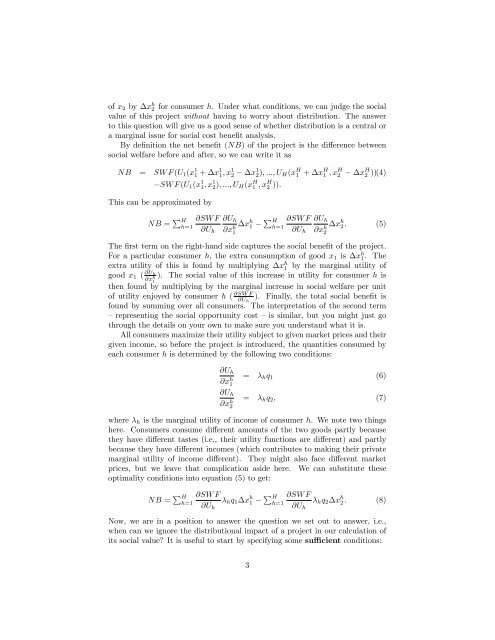Lecture Note 15: Social Cost Benefit Analysis - University of ...
Lecture Note 15: Social Cost Benefit Analysis - University of ...
Lecture Note 15: Social Cost Benefit Analysis - University of ...
Create successful ePaper yourself
Turn your PDF publications into a flip-book with our unique Google optimized e-Paper software.
<strong>of</strong> x2 by x h 2 for consumer h. Under what conditions, we can judge the social<br />
value <strong>of</strong> this project without having to worry about distribution. The answer<br />
to this question will give us a good sense <strong>of</strong> whether distribution is a central or<br />
a marginal issue for social cost bene…t analysis.<br />
By de…nition the net bene…t (NB) <strong>of</strong> the project is the di¤erence between<br />
social welfare before and after, so we can write it as<br />
NB = SW F (U1(x 1 1 + x 1 1; x 1 2 x 1 2); :::; UH(x H 1 + x H 1 ; x H 2 x H 2 ))(4)<br />
This can be approximated by<br />
SW F (U1(x 1 1; x 1 2); :::; UH(x H 1 ; x H 2 )):<br />
NB = PH @SW F @Uh<br />
h=1 @Uh @xh 1<br />
x h 1<br />
PH @SW F @Uh<br />
h=1 @Uh @xh 2<br />
x h 2: (5)<br />
The …rst term on the right-hand side captures the social bene…t <strong>of</strong> the project.<br />
For a particular consumer h, the extra consumption <strong>of</strong> good x1 is x h 1. The<br />
extra utility <strong>of</strong> this is found by multiplying x h 1 by the marginal utility <strong>of</strong><br />
good x1 ( @Uh<br />
@x h 1<br />
). The social value <strong>of</strong> this increase in utility for consumer h is<br />
then found by multiplying by the marginal increase in social welfare per unit<br />
@SW F<br />
<strong>of</strong> utility enjoyed by consumer h ( ). Finally, the total social bene…t is<br />
@Uh<br />
found by summing over all consumers. The interpretation <strong>of</strong> the second term<br />
– representing the social opportunity cost – is similar, but you might just go<br />
through the details on your own to make sure you understand what it is.<br />
All consumers maximize their utility subject to given market prices and their<br />
given income, so before the project is introduced, the quantities consumed by<br />
each consumer h is determined by the following two conditions:<br />
@Uh<br />
@x h 1<br />
@Uh<br />
@x h 2<br />
= hq1 (6)<br />
= hq2; (7)<br />
where h is the marginal utility <strong>of</strong> income <strong>of</strong> consumer h. We note two things<br />
here. Consumers consume di¤erent amounts <strong>of</strong> the two goods partly because<br />
they have di¤erent tastes (i.e., their utility functions are di¤erent) and partly<br />
because they have di¤erent incomes (which contributes to making their private<br />
marginal utility <strong>of</strong> income di¤erent). They might also face di¤erent market<br />
prices, but we leave that complication aside here. We can substitute these<br />
optimality conditions into equation (5) to get:<br />
NB = PH @SW F<br />
h=1 @Uh<br />
hq1 x h 1<br />
PH @SW F<br />
h=1 @Uh<br />
hq2 x h 2: (8)<br />
Now, we are in a position to answer the question we set out to answer, i.e.,<br />
when can we ignore the distributional impact <strong>of</strong> a project in our calculation <strong>of</strong><br />
its social value? It is useful to start by specifying some su¢ cient conditions:<br />
3


